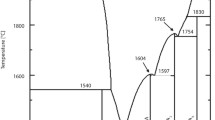Abstract
A new composite binder composed of low-density liquid glass, ferrochrome slag, and alumina cement is developed. A comparative analysis of the physicomechanical properties of the composite binder and a traditional liquid-glass binder are compared. The role of alumina cement in the hardening of the composite binder is discussed.
Similar content being viewed by others
REFERENCES
K. D. Nekrasov, Refractory Concrete [in Russian], Promstroiizdat, Moscow (1957).
A. P. Tarasova, Refractory Binders and Concretes Based on Liquid Glass [in Russian], Stroiizdat, Moscow (1982).
V. N. Sokov, “Physicochemical analysis of a hot-pressed chamotte-polystyrene system based on liquid glass, ” Ogneup. Tekh. Keram., No. 3, 2-4 (1998).
S. F. Koren'kova, A. I. Khlystov, and T. V. Sheina, “Uses of a refractory concrete based on sodium silicate composite binder, ” Beton Zhelezobeton, No. 9, 4-6 (1992).
Production Instruction for Refractory Concretes (SN 156-79) [in Russian], Stroiizdat, Moscow (1979).
Instruction for the Erection and Installation of Thermal-Power Units Made of Refractory Concrete [in Russian], Stroiizdat, Moscow (1983).
S. D. Teplyakov, “Structure and physicochemical characteristics of sodium liquid glass, ” Liteinoe Proizvod., No. 5, 18-20 (1984).
B. D. Toturbiev, Building Materials Based on Sodium Silicate Composites [in Russian], Stroiizdat, Moscow (1988).
V. N. Sokov, “Nonfired lightweight chamotte components obtained by active high-temperature synthesis in a hydrothermal field, ” Ogneup. Tekh. Keram., No. 1, 3-11 (1998).
N. P. Bessmertnyi and S. M. Ushatkin, “Preparation of a liquid glass with tailored characteristics, ” in: Lightweight Concretes and the Thermal Resistance of Steel Concrete Structures. Coll. of Res. Papers [in Russian], Penzastroimaterialy Production Association, Penza (1988), pp. 59-61.
V. I. Korneev and V. V. Danilov, Production and Application of Liquid Glass [in Russian], Leningrad (1991).
V. Antonovic, S. Goberis, and A. Spokauskas, “The reaction character between aluminous cement and liquid glass, ” Chem. Technol. (Kaunas), No. 3(12), 55-58 (1999).
J. Deltuva, The Structure and Properties of Heterogeneous Building Mixtures, Kaunas (1998).
V. Antonovic and S. Goberis, “The effect of liquid glass on the deformation of refractory binder, ” Civil Eng. (Vilnius), 7(1), 29-33 (2001).
V. Antonovic, S. Goberis, and R. Maciulaitis, “The effect of sodium silicate and its solution on the properties of a refractory complex binder, ” Civil Eng. (Vilnius), 5(3), 211-216 (1999).
V. Antonovic and S. Goberis, “The effect of liquid glass density on the formation and the structure of a complex refractory binder after hardening and firing at high temperature, ” Mater. Sci. (Kaunas), 6(4), 308-311 (2000).
P. A. Borsuk and A. M. Lyass, Liquid Self-Setting Mixtures [in Russian], Mashinostroenie, Moscow (1979).
T. V. Kuznetsova, “Basic physical chemistry in the fabrication of high-alumina cements, ” in: Basic Physical Chemistry and Technology of Refractory Cements [in Russian], Nauka, Moscow (1986), pp. 14-30.
Author information
Authors and Affiliations
Rights and permissions
About this article
Cite this article
Goberis, S., Antonovic, V. & Maciulaitis, R. A Refractory Binder Based on Liquid Glass and Alumina Cement. Refractories and Industrial Ceramics 43, 188–192 (2002). https://doi.org/10.1023/A:1020575318724
Issue Date:
DOI: https://doi.org/10.1023/A:1020575318724




